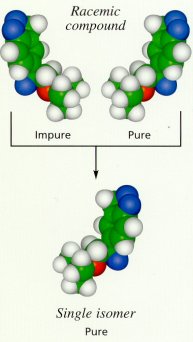|
Bronchodilators |
Most drug effects are mediated through the agency of a receptor, which is special protein molecule on the cell membrane which is specifically designed to interact with natural body chemicals, and it also interacts with drugs.
 |
There are many types
of receptors throughout the body. For example, andrengic receptors
are part of the sympathetic nervous system and are activated
by the natural neurotransmitters epinephrine, norepinephrine, and
dopamine, or by drugs. There are three types of andrenergic receptors
(alpha, beta1, and beta2).
Cholinergic receptors are part of the parasympathetic
nervous system, and are activated by the natural neurotransmitter
acetylcholine. The G protein-linked receptors mediate both bronchodilation and bronchoconstriction in the airways, in response to endogenous stimulation by neurotransmitters epinephrine and acetylcholine. These same airway responses can also be elicited by andrenergic bronchodilator drugs, or blocked by acetylcholine blocking (anticholinergic) agents. |
Bronchodilators relax the smooth muscle that surrounds the bronchi, thereby increasing air flow. This dilation of the bronchi is due either to stimulation of beta2 receptors in the smooth muscle of the bronchi, the release of epinephrine which itself stimulates beta2 receptors, or to inhibition of acetylcholine at cholinergic receptor sites in the smooth muscle.
Beta Andrenergic Agonists
Andrenergic bronchodilators are the most widely used of all medications in respiratory therapy. The name andrenergic comes from their ability to act like adrenalin on the beta sites and cause smooth muscle relaxation.
At the effector site, the bronchial smooth muscle cell, the stimulation of the beta site results in the stimulation of adenyl cyclase, which in turn catalyzes the formation cyclic 3',5' adenosine monophosphate (cAMP) from adenosine triphosphate (ATP). The presence of cAMP causes the smooth muscle to relax, leading to bronchodilation. cAMP is inactivated by the enzyme phosphodiesterase into AMP, losing the bronchodilatory effect. Stimulation of the bronchial smooth muscle beta site, whether by sympathetic system or by sympathomimetic drug, increases the level of 3'5' AMP, and results in dilation.
The bronchodilating action of the adrenergic drugs is primarily caused by stimulation of beta2 receptors located on bronchial smooth muscle. In addition, some adrenergic bronchodilators can stimulate alpha and beta1 receptors. The clinical effects of these stimulations include:
- Alpha receptor stimulation causes vasoconstriction and a vasopressor effect; in the upper airway (nasal passages) this can provide decongestion.
- Beta1 receptor stimulation causes increased myocardial conductivity, increased heart rate, and increased contractile force.
- Beta2 receptor stimulation can cause:
- relaxation of bronchial smooth muscle
- inhibition of inflammatory mediator release
- stimulation of mucociliary clearance
The general indication for the use of andrenergic bronchodilators is relaxation of airway smooth muscle to reverse or improve airflow obstruction. They are used clinically to reverse bronchoconstriction seen with asthma, acute and chronic bronchitis, emphysema, bronchiectasis, cystic fibrosis, and other obstructive airway diseases.
The sympathomimetic bronchodilators are all either catecholamines or derivatives of catecholamines. Catecholamines, or sympathomimetic amines, mimic the actions of epinephrine fairly precisely, causing tachycardia, elevated blood pressure, smooth muscle relaxation of bronchioles and skeletal muscle blood vessels, glycogenolysis, skeletal muscle tremor, and central nervous system stimulation.